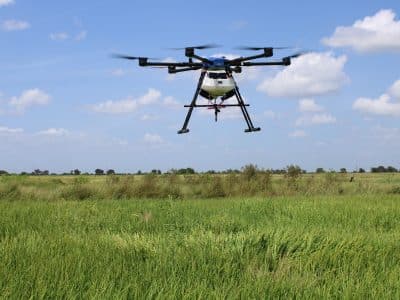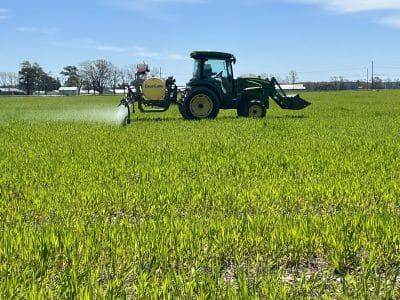Posted: May 31, 2017 by Bill Curran and Dwight Lingenfelter in Penn State Field Crop News.
Herbicides in new grass and legume seedings
Herbicide options for new forage grass and/or legume seedings are limited. Most herbicide labels for grasses like orchardgrass, timothy, etc. state that the grasses should be well established with at least 4-5 inches of growth. Some labels are more restrictive than this. The metsulfuron label states that grasses should be established for at least 6 months prior to an application. This ensures that they are developing a solid root system that could tolerate potential stress from the herbicide. Herbicide selection, formulation (ester vs. amine) rate, and environmental conditions at application will all impact the potential for injury. Herbicide use in new legume seedings has similar concerns. In general, legumes should have several trifoliate leaves and be 2 to 3 inches tall before making an application. The Pursuit and Raptor labels state that alfalfa should have 2 trifoliates or larger at application; two of the most lenient products for new alfalfa seedings. To complicate things further, at the time our crops are still developing sufficient growth, our targets are generally “small” annual weeds which are easier to kill – a bit of a paradox. Finally, products are even more limited with mixed seedings. Pursuit is labeled for established alfalfa-grass mixtures as is metribuzin (Dimetric, Glory, TriCor, etc.); MCPA and Maestro (Buctril) are labeled on legume/small grain companion seedings, and several other products have labels for CREP mixtures.
Established hay and pasture
The flowering stage is an excellent time to attempt some control of poisonous perennial plants. A number of common plants can be poisonous when eaten in sufficient quantity by livestock, so monitor those pasture and hay fields closely. Perennial weeds are most sensitive to control with a systemic herbicide when they are in the bud to bloom stage and in late summer. Biennials including musk and plumless thistle, burdock, wild carrot, etc. should be treated before they begin to bolt (they are bolting now or very soon) and the smaller the better. Late fall or early spring is even a better time to treat them. And finally, control summer annual weeds as soon after they emerge as possible when they are most sensitive to chemical control. Below are some guidelines to provide a quick management summary for some common weeds of pasture.
Management guidelines for problem weeds of pastures
Annuals
Winter annuals (Mustard species, common chickweed, etc.)
- Mow after bolting to prevent seed production
- Apply an effective herbicide in fall or spring prior to bolting
- Most winter annuals emerge by late fall – a smaller percentage will emerge in early spring
- Prevent seed production to prevent spread
Summer annuals (Pigweed species, common lambsquarters, common ragweed, etc.)
- Keep pasture full and competitive
- Mow after bolting to prevent seed production
- Apply an effective herbicide in early summer
- Prevent seed production to prevent spread
Grasses – grasses can be challenging to manage in pastures. See this fact sheet from Oregon State University for information on managing foxtail in pastures and hayground.
Biennials
Biennials (common burdock, bull and musk thistle, poison hemlock, etc.)
- Mow after plants have bolted but before seed set to prevent seed production
- Remove or dig individual plants by hand
- Apply an effective herbicide to rosettes in the spring or fall
- Prevent seed production to prevent spread
- Several insect biocontrol tools may help with thistles in the future
Perennials
Creeping perennials (Canada thistle, horsenettle, etc.)
- Mow to suppress vegetative growth and prevent seed production
- Spray with an effective systemic herbicide at bud to bloom stage or in early fall prior to frost
- Most perennials spread by both seed and vegetative structures
Woody perennials (multiflora rose, autumn olive, etc.)
- Mow to suppress and prevent seed production – remove roots by hand or with heavy equipment
- Spray with an effective systemic herbicide at bud to bloom stage or in early fall
- Rose rosette disease has spread as far North as Central PA and may impact this weed in the future
Multiflora rose control in pastures
As spring progresses, multiflora rose begins its growth and eventually blooms in late May through early June. Certain herbicides can provide good control of multiflora rose, especially when applied during the bud to bloom growth stages. Several foliar applied herbicides are suggested for late-spring/summer including Cimarron Plus/metsulfuron, Crossbow/Remedy Ultra, GrazonNext HL, and glyphosate.
No matter which control tactic is used, follow-up maintenance practices are a must for long-term control of multiflora rose. Removal of dead brush, annual mowing, and adequate soil fertility are examples of practices that should be used to maintain control of multiflora rose and in turn, will encourage pasture growth.
On a side note, rose rosette disease (RRD) on multiflora rose (Rosa multiflora) is a common sight in the midwest, mid-Atlantic, and other scattered states. RRD is a suspected virus transmitted by an eriophyid mite that is a generally fatal to multiflora rose as well as some other rose species. Farmers and land managers plagued with multiflora rose have happily anticipated the arrival of RRD in the hope that it will reduce or even eliminate multiflora rose. Unfortunately, some ornamental roses are also susceptible, so rose enthusiasts are equally concerned about the spread of RRD. Although many farmers and other landowners may welcome RRD, don’t expect it to solve the multiflora rose problem any time soon. Our experience has been that for every plant that dies from the disease, two or three new ones become established over that period of time.


